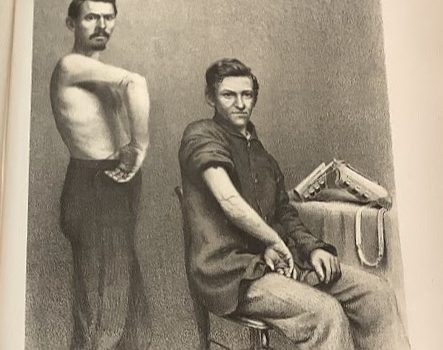The history of surgery is long and varied, dating back thousands of years across the world. Several books in the the Library’s Historical Collection offer fascinating glimpses into some of the surgical practices of the past. This blogpost will investigate some of them and the history of their publication. Please note that some of the illustrations below depict injuries in detail.
The Genuine Works of Hippocrates
The Genuine Works of Hippocrates was published in 1849 by the Sydenham Society. The translator of the Greek texts was Francis Adams. Adams was, according to a short biographical entry published in the Scottish Medical Journal, a doctor with a practice in the town of Banchory, just west of Aberdeen. He also found time to self-teach and translate medical texts in Latin, Greek and Arabic. Alongside Hippocrates, his published translations included works by Paul of Aegineta and Aretaeus of Cappadocia. He also produced a book entitled Arundines Devae; or, poetical translations on a new principle, which contained translations of Horace’s odes into English and translations of English poetry into Latin and Greek.
The Hippocratic treatises Adams translates in these two volumes are On Ancient Medicine, On Airs, Waters, and Places, On the Prognostics, On Regimen in Acute Diseases, Epidemics (books 1 and 3), On Injuries of the Head, On Things Relating to the Surgery, On Fractures, On the Articulations, Mochlicus, The Aphorisms, The Oath, The Law, On Ulcers, On Fistulae, On Haemorrhoids, and On the Sacred Disease. Nowadays, ancient Greek medical historians are more cautious about these texts’ (and others’) attributions to Hippocrates himself, and tend to refer to them collectively as the ‘Hippocratic Corpus’ instead.
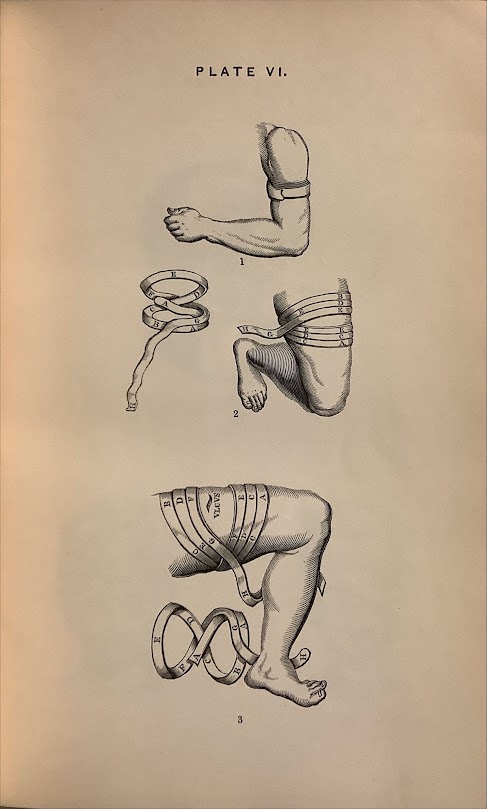

Of especial interest to us, of course, is the treatise On Things Relating to the Surgery. The plates pictured above, from Volume Two, illustrate some of the bandaging techniques described. In the original captions, these bandaging techniques have Latin names like Monoculus (plate VII.1 above) or Sima sincera inaequalis (plate VI.3 above). Intriguingly, the caption also attributes the illustrations in Plate VI to “the Venetian edition of Galen.” (volume 6). This may refer to the first modern Latin translation of the works of Galen, which included a commentary on this treatise.
The bookplate on the inside cover of both volumes suggests that they entered the Library in May 1948. Unfortunately, the books themselves don’t have any evidence for where they spent the previous century.
Lehrbuch der Kriegschirurgie
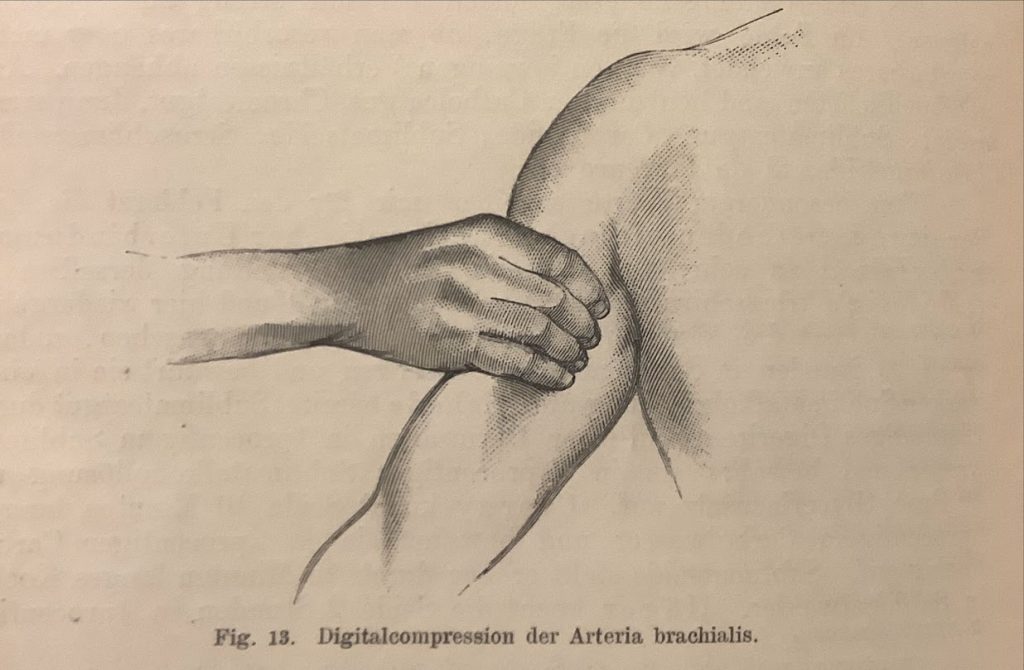
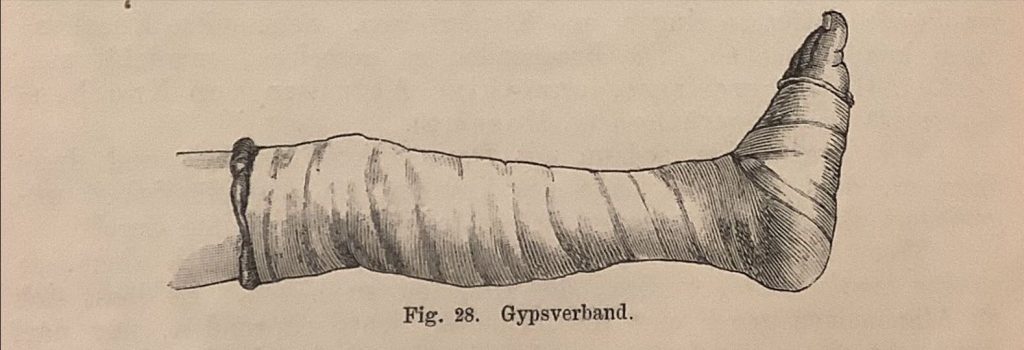
This book is bound with another work, this time on malaria, entitled Die malaria-parasiten auf grund fremder und eigener beobachtungen dargestellt. For more on malaria in the Historical Collection, see this other blogpost in our series. Our surgical book, however, whose title is translatable as “Textbook of War Surgery,” is exactly what the title might suggest. The book itself, published in 1893, deals with field surgery for soldiers. It includes instructions on amenities and technologies like surgery tents or ambulances. The detailed illustrations include those above, of a gypsum plaster cast on a leg and how to compress the arteries of the arm with one’s fingers.
The book’s author, Karl (von) Seydel, was a medical professor and a doctor in the Bavarian army at the beginning of the twentieth century. He says in his foreword that this book is part of a larger book series from the publisher Ferdinand Enke. His language in this foreword makes his ideological background clear: he describes the book’s main purpose as the alleviation of wounded soldiers’ plights and thus in turn the well-being of the army and the ‘fatherland’ (Vaterland).
Medical and Surgical History of the War of the Rebellion
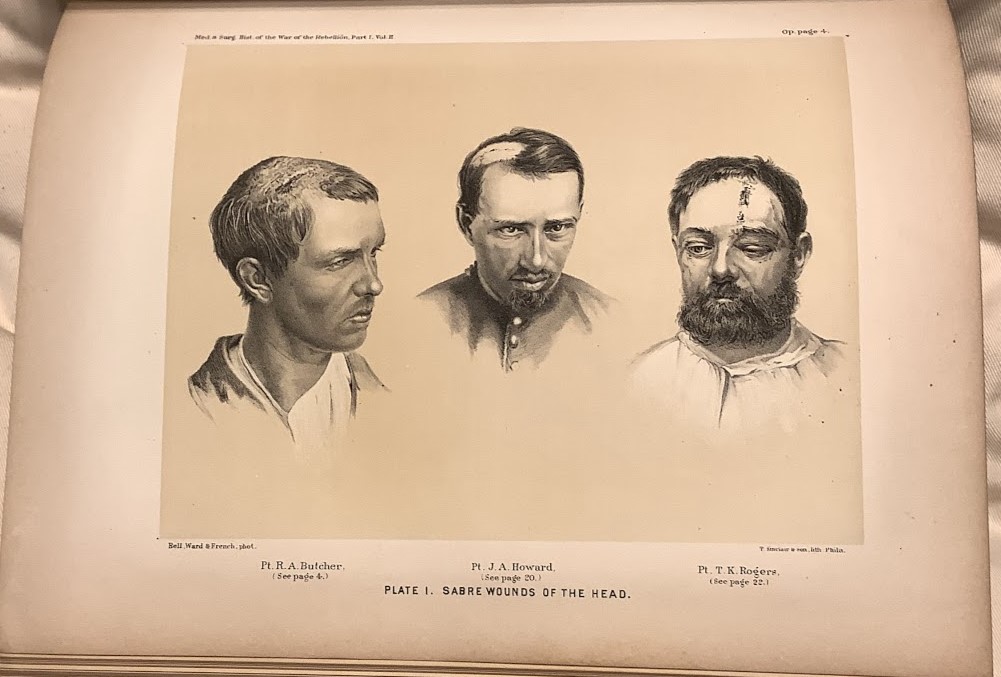
This six-part publication was produced by the US Army Surgeon General’s Office and consisted of a vast number of detailed case histories of diseases and surgical operations performed during the American Civil War. It also includes a host of other information like reports on prisoner-of-war camps, charts, and accounts of battles. For this reason, medical historians used it as a valuable resource on Civil War medical history, according to Ira M. Rutkow. It is available online on the data Internet Archive and the National Library of Medicine. Its Wikipedia article provides a detailed publication history and describe how the series consists of three volumes, each of which had a separate part dedicated to medical or surgical history. Each part was bound as a separate book.
Most striking of all are the detailed illustrations from the volumes on surgery, depicting injuries, surgical procedures, or bullets extracted from wounds.
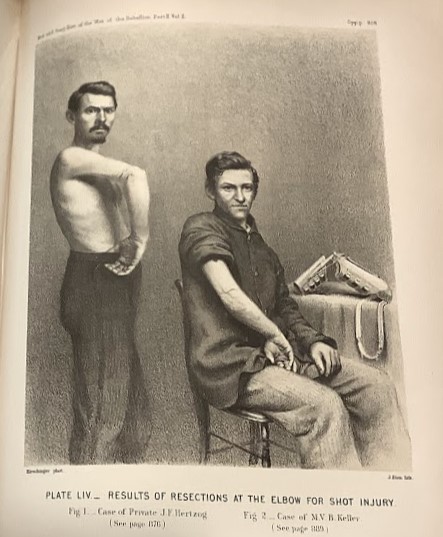
These images, for instance, depict “resections” (i.e., operations done to remove tissue) on two men’s elbows after they sustained shot injuries, and gushot wounds sustained to the face and neck. Additionally, the injured men are each named and their rank and regiment is given. For instance, the lower image is a “chromolith” by “J. Bien”. Additionally, the caption names the two pictured men as Private Anthony Spiegel (left) and Private Albert Silsbee (right). It gives their regiments as the 5th U.S Cavalry and the 86th New York Volunteers respectively, both Union regiments. The technology for a chromolithograph had only developed relatively recently, but was rapidly growing in popularity at the time. Its inclusion for numerous colour plates in this publication is therefore unsurprising.
How to get these books
Library users are welcome to consult any of these books on Library premises. Each of the books discussed above has their catalogue entry linked in the section title. To reserve a book for consultation, just go to their catalogue entry on Discover while logged into your LSHTM account and follow the instructions underneath the heading “Get It.” You’ll receive an email when it’s available. However, please note that you will need to read these books within the Library and cannot borrow them like most other resources.




